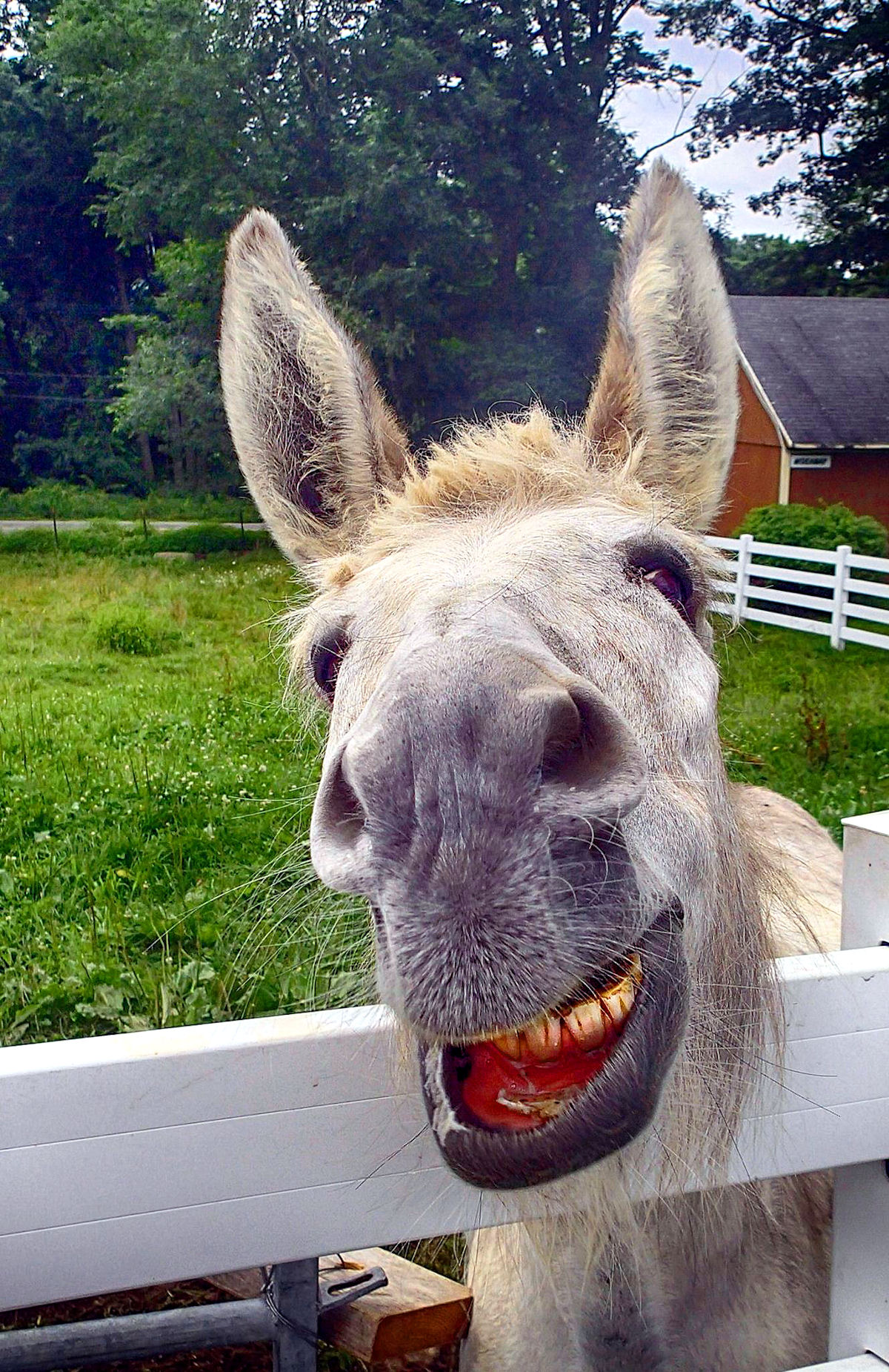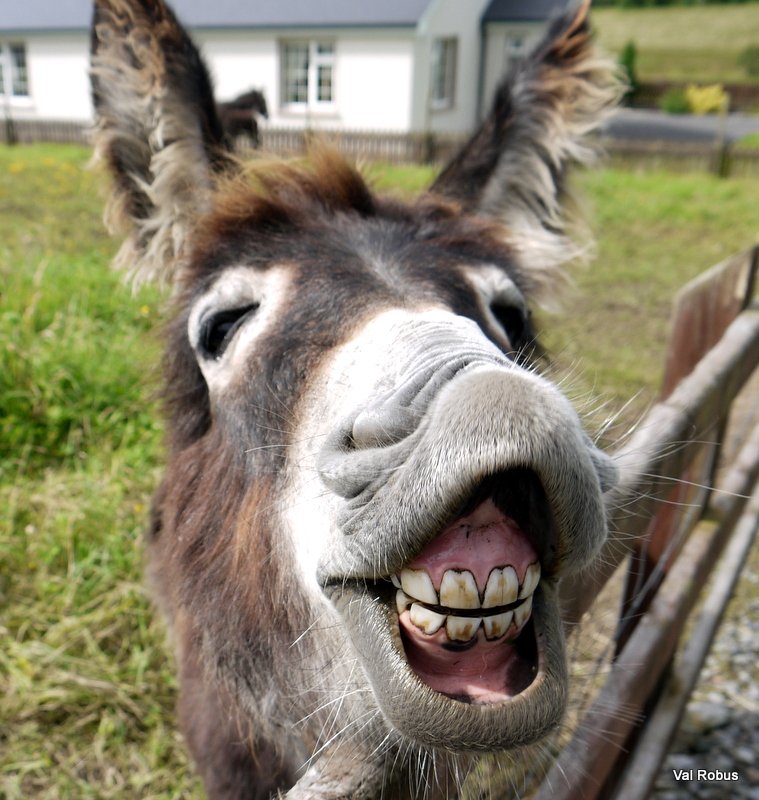The Truth About Donkey Smiles: Uncovering Equine Joy
For centuries, donkeys have been an indispensable part of human civilization, revered for their strength, resilience, and often, their stoic demeanor. Yet, a delightful phenomenon has captured the hearts of many in recent years: the sight of a donkey smiling. This seemingly simple act has sparked curiosity, joy, and even scientific inquiry, prompting us to look beyond their traditional image and discover a more nuanced, perhaps even gleeful, side to these remarkable equines.
The internet, in particular, has become a vibrant canvas for sharing these heartwarming moments, from charming photos to captivating videos, proving that the infectious grin of a donkey can indeed brighten anyone's day. But what exactly constitutes a "donkey smile," and what does it truly reveal about their inner world? Is it a genuine expression of happiness, or simply a fascinating quirk of their anatomy? Let's delve into the delightful world of smiling donkeys and uncover the secrets behind their beaming expressions.
Table of Contents
- What is a Donkey Smile? Decoding Equine Expressions
- The Science Behind the Grin: Understanding Donkey Anatomy and Behavior
- Factors That Bring Joy to Donkeys: Creating an Environment for Happiness
- The Power of Imagery: Donkey Smiles in Media and Popular Culture
- Donkeys as Emotional Beings: Empathy and Connection
- Caring for Happy Donkeys: Promoting Their Well-being
- Ethical Considerations: Interpreting Animal Emotions Responsibly
- The Lasting Impact of a Donkey Smile: A Source of Human Happiness
What is a Donkey Smile? Decoding Equine Expressions
The term "donkey smiling" often refers to a particular facial expression where the donkey appears to pull back its lips, revealing its teeth, sometimes accompanied by a crinkling around the eyes. For humans, this expression is universally recognized as a smile – a sign of happiness, amusement, or friendliness. When we see a donkey exhibiting this, our immediate, instinctive reaction is often one of delight and a strong belief that the animal is experiencing joy. However, it's crucial to approach animal behavior with both empathy and a degree of scientific understanding. While a donkey might not "smile" in the exact same way a human does, this doesn't diminish the positive interpretation of the gesture. Many animal behaviors that we interpret as human-like emotions are often complex combinations of physiological responses, social cues, and environmental factors. For donkeys, this expression can sometimes be a variation of the "flehmen response," where an animal curls back its upper lip to expose its vomeronasal organ, allowing it to better detect scents, particularly pheromones. While primarily olfactory, the flehmen response can, in certain contexts, look remarkably like a grin. Yet, there are also instances where the expression seems to go beyond a mere physiological reflex, genuinely appearing to be linked to a moment of contentment or playfulness. This is where the magic of the "donkey smiling" phenomenon truly lies – in the delightful ambiguity that allows us to project our own joy onto these gentle creatures.The Science Behind the Grin: Understanding Donkey Anatomy and Behavior
To truly understand the "donkey smiling" phenomenon, we need to look at the anatomy and natural behaviors of these fascinating animals. Donkeys, like horses, possess highly mobile lips and nostrils, which are essential for grazing, vocalization, and social interaction. Their facial muscles allow for a range of expressions, though perhaps not as overtly diverse as those of primates. When a donkey pulls back its lips, it might be: * **The Flehmen Response:** As mentioned, this is a common behavior in many ungulates. It's not an expression of emotion but a sensory action. However, the visual result often resembles a human smile. * **Anticipation of Food:** Donkeys are highly food-motivated. An open-mouthed, lip-curled expression could be a sign of excitement or anticipation when food is presented. * **Social Signaling:** While less studied than in horses, donkeys use facial expressions as part of their complex social communication. A relaxed, open-mouthed expression might indicate contentment or a non-threatening posture within their herd. * **Play Behavior:** Young donkeys, especially, engage in playful interactions that can involve mouthing, nipping, and various facial contortions that, to the human eye, might look like a playful grin. * **Comfort or Relaxation:** When donkeys are truly relaxed and comfortable in their environment, their facial muscles may loosen, leading to an expression that we interpret as a smile. This is often seen when they are being groomed or are resting peacefully. Researchers in animal behavior are increasingly using tools like the Equine Pain Face Scale (EPFS) to objectively assess discomfort or pain in equids by observing subtle facial changes. While these scales focus on negative states, the very existence of such tools highlights that donkeys do convey information through their faces. Therefore, it's not a stretch to suggest that positive emotional states could also manifest in discernible, albeit perhaps subtle, facial cues, which we interpret as a delightful "donkey smiling."Factors That Bring Joy to Donkeys: Creating an Environment for Happiness
If we accept the premise that donkeys can experience states of contentment or joy, what are the conditions that foster such positive emotions? Understanding these factors is key to promoting the well-being of donkeys, whether they are working animals, beloved pets, or residents of sanctuaries. A truly happy donkey is more likely to exhibit the relaxed, perhaps even "smiling," expressions that captivate us.Social Connections and Herd Dynamics
Donkeys are inherently social animals. They thrive in the company of other donkeys, forming strong bonds and complex social hierarchies. Isolation can lead to stress and behavioral issues. Providing opportunities for donkeys to interact, groom each other, and simply exist together in a herd environment is paramount for their mental and emotional health. A donkey that feels secure and connected within its social group is a content donkey, and this contentment can certainly manifest in relaxed facial expressions that we might perceive as a "donkey smiling." This is why sanctuaries often emphasize keeping donkeys in groups, recognizing their deep need for companionship.Physical Comfort and Well-being
Just like humans, donkeys experience joy when their basic needs are met and they are free from discomfort or pain. This includes:- **Proper Nutrition:** A balanced diet appropriate for their age, activity level, and health status.
- **Clean Water:** Constant access to fresh, clean water.
- **Shelter:** Protection from extreme weather conditions (sun, rain, wind).
- **Veterinary Care:** Regular check-ups, vaccinations, deworming, and prompt attention to any health issues.
- **Hoof Care:** Regular trimming by a farrier is crucial for their mobility and overall health.
- **Enrichment:** Opportunities for mental stimulation and physical exercise, such as varied pasture, safe toys, or even simple walks.
The Power of Imagery: Donkey Smiles in Media and Popular Culture
The rise of digital media has played an enormous role in popularizing the "donkey smiling" phenomenon. What was once a rare, anecdotal sighting is now a readily shareable, viral sensation. The sheer volume of images and videos available online testifies to the universal appeal of a happy donkey.Stock Photos and Their Impact
The demand for visuals of cheerful donkeys is evident in the vast libraries of stock photography. You can "find cute, funny, cartoon and realistic donkey images for your projects or personal use." Platforms boast "download and use 200,000+ donkey+smiling stock photos for free," and "browse and download over 30,000 high resolution images of smiling donkeys for free." The availability of "authentic smiling donkey stock photos & images for your project or campaign" means that this positive imagery is easily accessible for commercial designs under lifetime, perpetual & worldwide rights. This widespread availability helps to normalize the idea of donkeys as joyful creatures, shifting public perception from mere beasts of burden to endearing companions. The ability to "download donkey smiling stock photos" from communities like Dreamstime, "the world's largest stock photography community," further solidifies their place in our visual lexicon.Viral Videos and GIFs: Spreading the Joy
Beyond static images, dynamic content truly brings the "donkey smiling" experience to life. "Find smiling donkey gifs that make your conversations more positive, more expressive, and more you." These short, looping clips are perfect for sharing on social media, instantly conveying warmth and humor. Videos, too, have gone viral, with titles like "Donkey video bombs the white tiger with awesome smile" or "Check out this adorable donkey smiling for the camera." These "heartwarming video[s] capture the infectious smile of a donkey, and it's sure to brighten" anyone's day. The shared experience of witnessing a donkey's apparent joy creates a communal sense of happiness, fostering a deeper appreciation for these animals. "Share this funny donkey picture with your friends and spread the joy."Donkeys as Emotional Beings: Empathy and Connection
While scientific debate continues on the exact interpretation of a "donkey smile," there's no denying that donkeys are complex emotional beings. They exhibit a range of emotions, including fear, anxiety, curiosity, and contentment. Their gentle nature is well-known, and their capacity for forming strong bonds with humans and other animals is well-documented. When a donkey appears to be smiling, it resonates deeply with our human capacity for empathy. We project our understanding of joy onto them, and in doing so, we feel a connection that transcends species. This connection is not merely wishful thinking. Donkeys have been used in animal-assisted therapy for their calming presence and ability to interact gently with people, particularly those with special needs. Their quiet demeanor and expressive eyes often make them approachable, and the sight of a happy, relaxed donkey can have a profoundly positive effect on human well-being. "Donkeys are known for their gentle nature and this one is sure to brighten your day." The emotional bond formed with a donkey, whether through direct interaction or simply by observing their apparent joy, reinforces their status as sentient beings deserving of respect and compassionate care.Caring for Happy Donkeys: Promoting Their Well-being
For those who are captivated by the sight of a "donkey smiling," the natural next step is often to learn how to ensure donkeys are truly happy and well-cared for. Promoting a donkey's well-being goes far beyond simply providing food and water; it involves understanding their unique needs and providing an environment where they can thrive physically, mentally, and socially. Key aspects of responsible donkey care include: * **Appropriate Living Space:** Donkeys need ample space to roam, graze, and exercise. Overcrowding can lead to stress and aggression. * **Nutritional Management:** Donkeys are prone to obesity and laminitis if overfed or given rich pastures. Their diet should primarily consist of high-fiber, low-sugar forage. * **Regular Health Checks:** Routine veterinary care, including dental checks, vaccinations, and parasite control, is essential. Donkeys are stoic animals and may hide signs of illness, making regular professional oversight crucial. * **Hoof Care:** Their hooves grow continuously and require regular trimming (every 6-10 weeks) by a qualified farrier to prevent lameness and discomfort. * **Companionship:** As highly social animals, donkeys should never be kept alone. They need at least one other donkey companion. If another donkey isn't feasible, a horse, mule, or even a goat can sometimes serve as a suitable companion, though donkey-on-donkey companionship is ideal. * **Mental Stimulation:** Donkeys are intelligent and curious. Providing enrichment, such as puzzle feeders, safe toys, or varied environments, can prevent boredom and promote positive behaviors. * **Positive Reinforcement Training:** Training donkeys using gentle, consistent, and reward-based methods builds trust and strengthens the human-animal bond, making interactions more positive for both parties. By adhering to these principles, owners and caregivers can ensure their donkeys live fulfilling lives, increasing the likelihood of witnessing those heartwarming expressions that we interpret as genuine joy.Ethical Considerations: Interpreting Animal Emotions Responsibly
While the desire to see a "donkey smiling" comes from a place of genuine affection, it's important to approach the interpretation of animal emotions with a degree of scientific caution and ethical responsibility. Anthropomorphizing animals – attributing human emotions and characteristics to them – can sometimes lead to misunderstandings of their true needs or behaviors. For example, assuming a donkey's flehmen response is a "smile" might lead someone to overlook a potential health issue if the expression is also linked to discomfort, or to misinterpret a social signal. Responsible animal welfare advocates emphasize understanding species-specific behaviors rather than simply projecting human traits. However, this doesn't mean we should dismiss the idea of animal emotions entirely. Growing scientific evidence supports that animals, including donkeys, experience a range of emotions, from fear and anxiety to pleasure and contentment. The challenge lies in accurately identifying and interpreting these emotions based on their own unique behavioral repertoire, rather than solely through a human lens. The ethical imperative is to use our fascination with phenomena like "donkey smiling" as a gateway to deeper understanding and improved welfare. If seeing a happy donkey makes us feel good, then let that feeling translate into concrete actions that ensure donkeys everywhere are given the care, respect, and environment they need to truly thrive and experience their own forms of contentment.The Lasting Impact of a Donkey Smile: A Source of Human Happiness
Ultimately, the phenomenon of "donkey smiling" transcends mere scientific debate. It's a powerful reminder of the simple, profound joy that animals can bring into our lives. Whether it's a physiological response, a genuine expression of contentment, or a delightful combination of both, the sight of a donkey appearing to grin has an undeniable positive impact on human observers. It brightens our day, lifts our spirits, and fosters a sense of connection with the natural world. These moments, captured in "cute, funny, cartoon and realistic donkey images" or shared as "smiling donkey gifs," serve as tiny bursts of positivity in our often-busy lives. They remind us of the gentle nature of donkeys and their capacity to charm. The quest to "discover the truth behind donkeys' happy faces and learn why they are known to smile" leads us down a path of greater understanding, empathy, and a renewed commitment to animal welfare. So, the next time you encounter a "donkey smiling," whether in a viral video or in person, take a moment to appreciate the simple wonder of it. Let it "prepare you to be charmed by the most joyful donkey you've ever seen." It's a testament to the universal language of apparent happiness and the enduring bond between humans and these magnificent, often underestimated, creatures. What are your thoughts on donkey smiles? Have you ever witnessed a donkey that seemed to be grinning? Share your experiences and spread the joy in the comments below! If you enjoyed this exploration of equine happiness, be sure to check out our other articles on animal behavior and welfare.- Ww Xx
- Jayshree Web Series
- Securely Connect Remote Iot Vpc Raspberry Pi Aws Server
- Wisconsin Volleyball Team Leak
- Is Selena Samuela Pregnant

Donkey Smiling With Teeth

Donkey Face Smiling

Donkey Smiling With Teeth